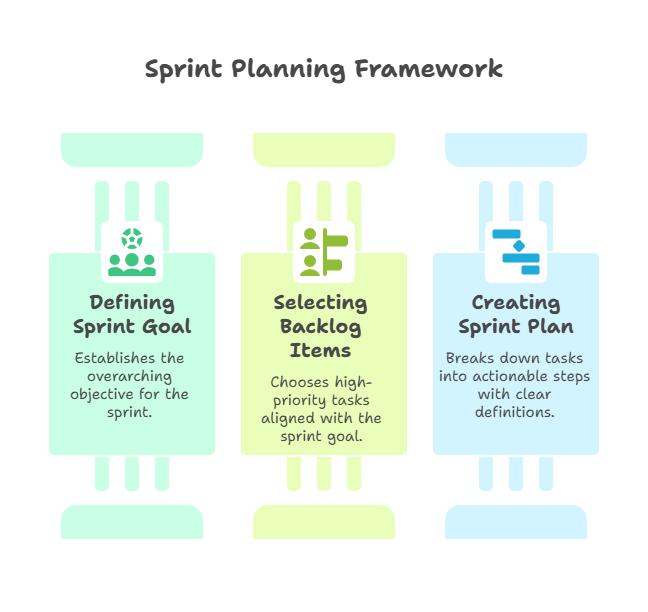How to Plan Product Sprints: A Practical Guide for Teams
Learn how to plan effective product sprints using agile methodology. This guide covers sprint planning meetings, goal setting, and practical frameworks for product managers.
What is Sprint Planning?
Sprint planning is a timeboxed event within the scrum framework that kicks off the upcoming sprint for agile teams. This collaborative session brings together the product owner, scrum master, and development team to determine what work will be completed during the sprint. The resulting sprint plan represents a negotiation between the development team and product owner based on value and effort considerations.
During sprint planning, teams decide which are the most valuable Product Backlog items to deliver in the next sprint. This process requires both an understanding of agile methodology and deep knowledge of your team, customers, and overall processes. Sprint planning meetings cannot be conducted effectively without the participation of both the product owner and development team.
The Three Key Components of Sprint Planning

Defining the Sprint Goal
The sprint goal serves as the overarching objective that guides the team's work throughout the sprint. According to agile experts, the product owner should come to sprint planning with a draft sprint goal that the team can refine together. This goal provides focus and direction, helping teams select relevant backlog items that contribute to achieving this objective.
A well-defined sprint goal answers the question: "What valuable outcome will we deliver by the end of this sprint?" It should be specific enough to provide direction but flexible enough to allow for adjustments as work progresses.
Selecting Backlog Items
The product owner needs to have the product backlog ready with the highest priority items at the top. These items should be relevant to the draft sprint goal and properly refined with clear acceptance criteria. Teams typically consider factors like business value, dependencies, and technical complexity when selecting which items to include in the sprint.
During this selection process, teams often reference agile metrics like velocity and throughput to ensure they're assigning the right amount of work. The development team provides estimates for each backlog item, creating a realistic plan that balances ambition with practical constraints.
Creating the Sprint Plan
The final component involves breaking down selected backlog items into specific tasks and activities. The development team defines how they will approach the work, identifying potential risks and dependencies. This detailed planning ensures everyone understands what needs to be done and how the work will be accomplished.
The sprint plan should include clear definitions of done for each item and establish how progress will be tracked throughout the sprint. Many teams use tools like Jira scrum templates to organize and visualize their sprint plans effectively.
Best Practices for Effective Sprint Planning
Prepare Thoroughly Before the Meeting
Successful sprint planning requires adequate preparation from all participants. The product owner should ensure the product backlog is properly groomed with clear priorities. Development team members should review backlog items in advance to identify potential questions or concerns.
Many teams find value in conducting pre-meeting discussions to address complex items or dependencies before the formal planning session. This preparation helps streamline the actual planning meeting and makes it more productive.
Focus on Collaboration and Negotiation
Sprint planning is fundamentally a collaborative process where the product owner represents stakeholder interests while the development team provides technical expertise. Both parties must engage in constructive negotiation to balance business value with technical feasibility.
The product owner explains why certain items are valuable, while the development team provides realistic estimates of what can be accomplished. This dialogue ensures the final sprint plan reflects both business priorities and practical constraints.
Keep the Meeting Timeboxed
Sprint planning meetings should be timeboxed to avoid analysis paralysis. A common guideline is to allocate two hours per week of sprint duration—so a two-week sprint would have a four-hour planning meeting. This time constraint encourages focus and efficiency while preventing the meeting from dragging on unnecessarily.
Within this timebox, teams should aim to complete all three components: defining the sprint goal, selecting backlog items, and creating the detailed sprint plan.
Common Sprint Planning Challenges
Unclear Priorities
One of the most frequent challenges teams face is unclear or shifting priorities from stakeholders. When the product owner cannot provide clear direction on what matters most, sprint planning becomes difficult and inefficient. The solution involves establishing strong product management practices and ensuring the product owner has a clear product vision.
Overcommitment
Teams often struggle with overcommitting to more work than they can realistically complete. This leads to missed deadlines, burnout, and reduced quality. Using historical velocity data and being realistic about capacity constraints can help prevent this common pitfall.
Technical Debt Accumulation
When teams consistently prioritize new features over maintenance and improvement work, technical debt accumulates and eventually slows development. Effective sprint planning balances new functionality with necessary technical work to maintain sustainable development pace.
Tools and Frameworks for Sprint Planning
Visual Planning with Mind Maps
For teams looking to improve their sprint planning process, visual tools like ClipMind can be incredibly valuable. Creating a sprint planning mind map helps teams visualize dependencies, identify potential bottlenecks, and ensure everyone shares the same understanding of the sprint goal and selected work items.
Mind mapping allows teams to see the big picture while maintaining visibility into detailed tasks and relationships between different backlog items. This visual approach can make complex sprint plans more accessible and easier to discuss during planning sessions.
Agile Project Management Tools
Most agile teams rely on specialized tools like Jira to manage their sprint planning process. These tools provide templates for sprint planning, backlog management, and progress tracking. They also facilitate collaboration between distributed team members and provide visibility into sprint progress.
For teams seeking to streamline their planning process, ClipMind's Project Planner offers a visual approach to organizing sprint tasks and dependencies. This can be particularly helpful for visual thinkers who benefit from seeing how different work items connect and relate to each other.
Measuring Sprint Planning Success
Effective sprint planning leads to predictable delivery of valuable functionality. Teams should regularly reflect on their planning process during sprint retrospectives and identify opportunities for improvement. Key indicators of successful sprint planning include consistent velocity, high-quality deliverables, and stakeholder satisfaction with the outcomes delivered each sprint.
By continuously refining their sprint planning approach, teams can become more efficient at translating product vision into actionable plans that deliver real value to customers and the business.
 ClipMind
ClipMind